Exxon Valdez Oil Spill: Examining Neoliberal Policies and Impacts
VerifiedAdded on 2023/06/11
|14
|4530
|279
Essay
AI Summary
This essay provides an in-depth analysis of the Exxon Valdez oil spill disaster, which occurred in Prince William Sound, Alaska, in 1989. It explores the failures in technological and organizational systems, as well as external factors that contributed to the spill. The essay also links the disaster to neoliberal policies and practices promoted by global institutions, highlighting the environmental degradation resulting from these policies. Furthermore, it discusses the cultural, social, and economic impacts of the oil spill on the citizens of Alaska, including damage to cultural foundations and economic instability. The essay concludes by touching on changes in government and Exxon's management systems implemented to prevent future occurrences of such disasters, emphasizing the importance of addressing both internal and external factors to ensure environmental protection and safety.
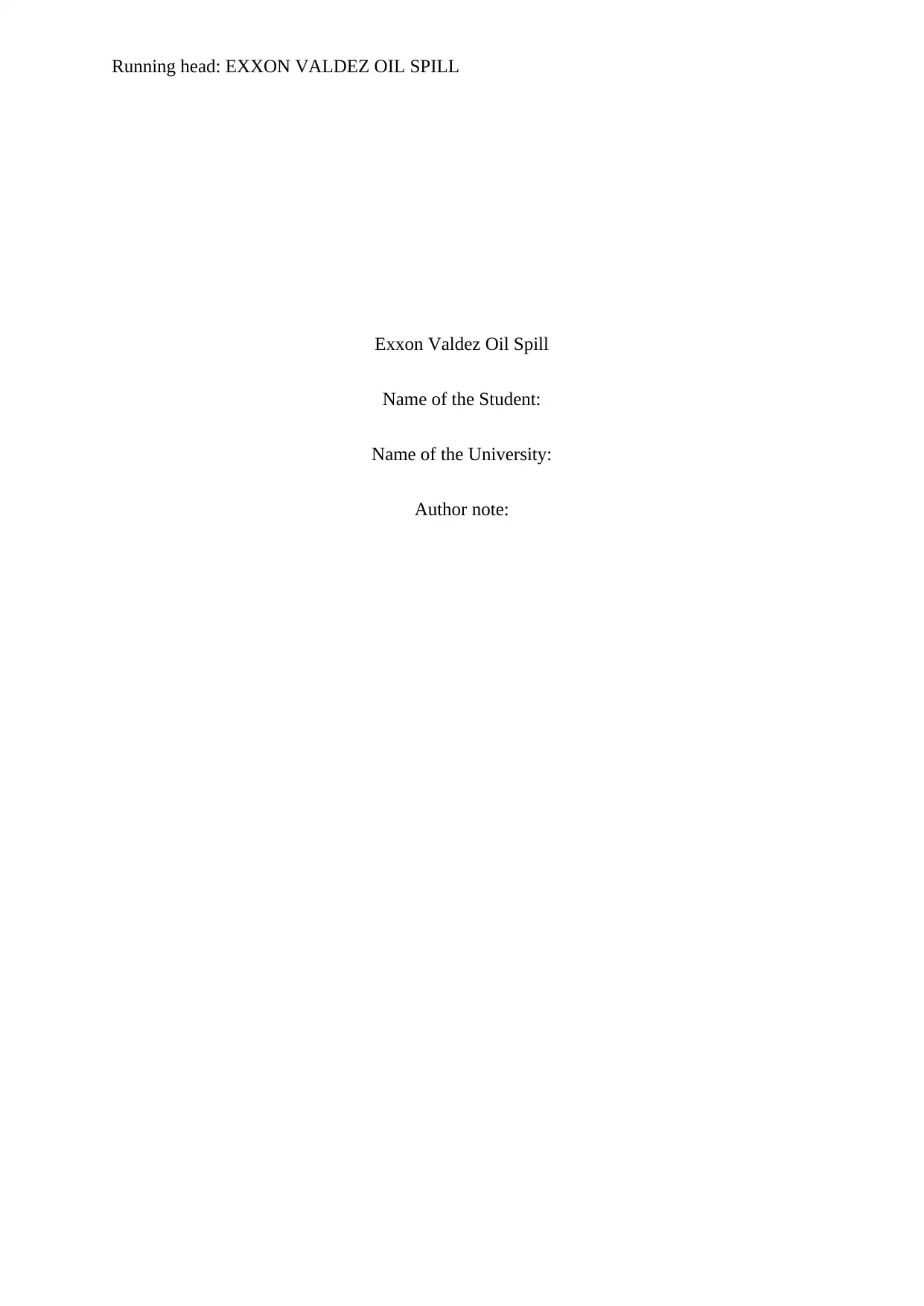
Running head: EXXON VALDEZ OIL SPILL
Exxon Valdez Oil Spill
Name of the Student:
Name of the University:
Author note:
Exxon Valdez Oil Spill
Name of the Student:
Name of the University:
Author note:
Paraphrase This Document
Need a fresh take? Get an instant paraphrase of this document with our AI Paraphraser
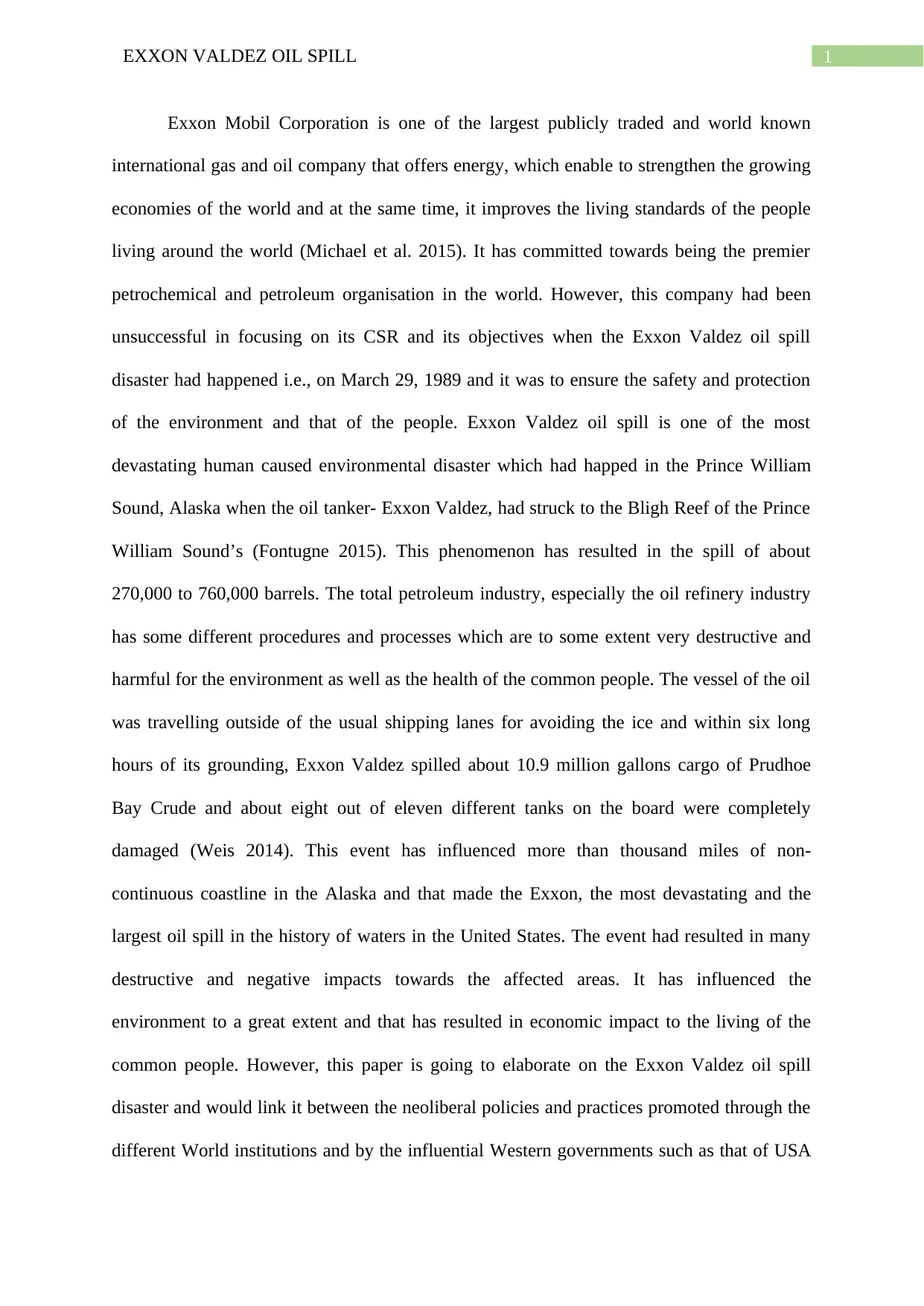
1EXXON VALDEZ OIL SPILL
Exxon Mobil Corporation is one of the largest publicly traded and world known
international gas and oil company that offers energy, which enable to strengthen the growing
economies of the world and at the same time, it improves the living standards of the people
living around the world (Michael et al. 2015). It has committed towards being the premier
petrochemical and petroleum organisation in the world. However, this company had been
unsuccessful in focusing on its CSR and its objectives when the Exxon Valdez oil spill
disaster had happened i.e., on March 29, 1989 and it was to ensure the safety and protection
of the environment and that of the people. Exxon Valdez oil spill is one of the most
devastating human caused environmental disaster which had happed in the Prince William
Sound, Alaska when the oil tanker- Exxon Valdez, had struck to the Bligh Reef of the Prince
William Sound’s (Fontugne 2015). This phenomenon has resulted in the spill of about
270,000 to 760,000 barrels. The total petroleum industry, especially the oil refinery industry
has some different procedures and processes which are to some extent very destructive and
harmful for the environment as well as the health of the common people. The vessel of the oil
was travelling outside of the usual shipping lanes for avoiding the ice and within six long
hours of its grounding, Exxon Valdez spilled about 10.9 million gallons cargo of Prudhoe
Bay Crude and about eight out of eleven different tanks on the board were completely
damaged (Weis 2014). This event has influenced more than thousand miles of non-
continuous coastline in the Alaska and that made the Exxon, the most devastating and the
largest oil spill in the history of waters in the United States. The event had resulted in many
destructive and negative impacts towards the affected areas. It has influenced the
environment to a great extent and that has resulted in economic impact to the living of the
common people. However, this paper is going to elaborate on the Exxon Valdez oil spill
disaster and would link it between the neoliberal policies and practices promoted through the
different World institutions and by the influential Western governments such as that of USA
Exxon Mobil Corporation is one of the largest publicly traded and world known
international gas and oil company that offers energy, which enable to strengthen the growing
economies of the world and at the same time, it improves the living standards of the people
living around the world (Michael et al. 2015). It has committed towards being the premier
petrochemical and petroleum organisation in the world. However, this company had been
unsuccessful in focusing on its CSR and its objectives when the Exxon Valdez oil spill
disaster had happened i.e., on March 29, 1989 and it was to ensure the safety and protection
of the environment and that of the people. Exxon Valdez oil spill is one of the most
devastating human caused environmental disaster which had happed in the Prince William
Sound, Alaska when the oil tanker- Exxon Valdez, had struck to the Bligh Reef of the Prince
William Sound’s (Fontugne 2015). This phenomenon has resulted in the spill of about
270,000 to 760,000 barrels. The total petroleum industry, especially the oil refinery industry
has some different procedures and processes which are to some extent very destructive and
harmful for the environment as well as the health of the common people. The vessel of the oil
was travelling outside of the usual shipping lanes for avoiding the ice and within six long
hours of its grounding, Exxon Valdez spilled about 10.9 million gallons cargo of Prudhoe
Bay Crude and about eight out of eleven different tanks on the board were completely
damaged (Weis 2014). This event has influenced more than thousand miles of non-
continuous coastline in the Alaska and that made the Exxon, the most devastating and the
largest oil spill in the history of waters in the United States. The event had resulted in many
destructive and negative impacts towards the affected areas. It has influenced the
environment to a great extent and that has resulted in economic impact to the living of the
common people. However, this paper is going to elaborate on the Exxon Valdez oil spill
disaster and would link it between the neoliberal policies and practices promoted through the
different World institutions and by the influential Western governments such as that of USA
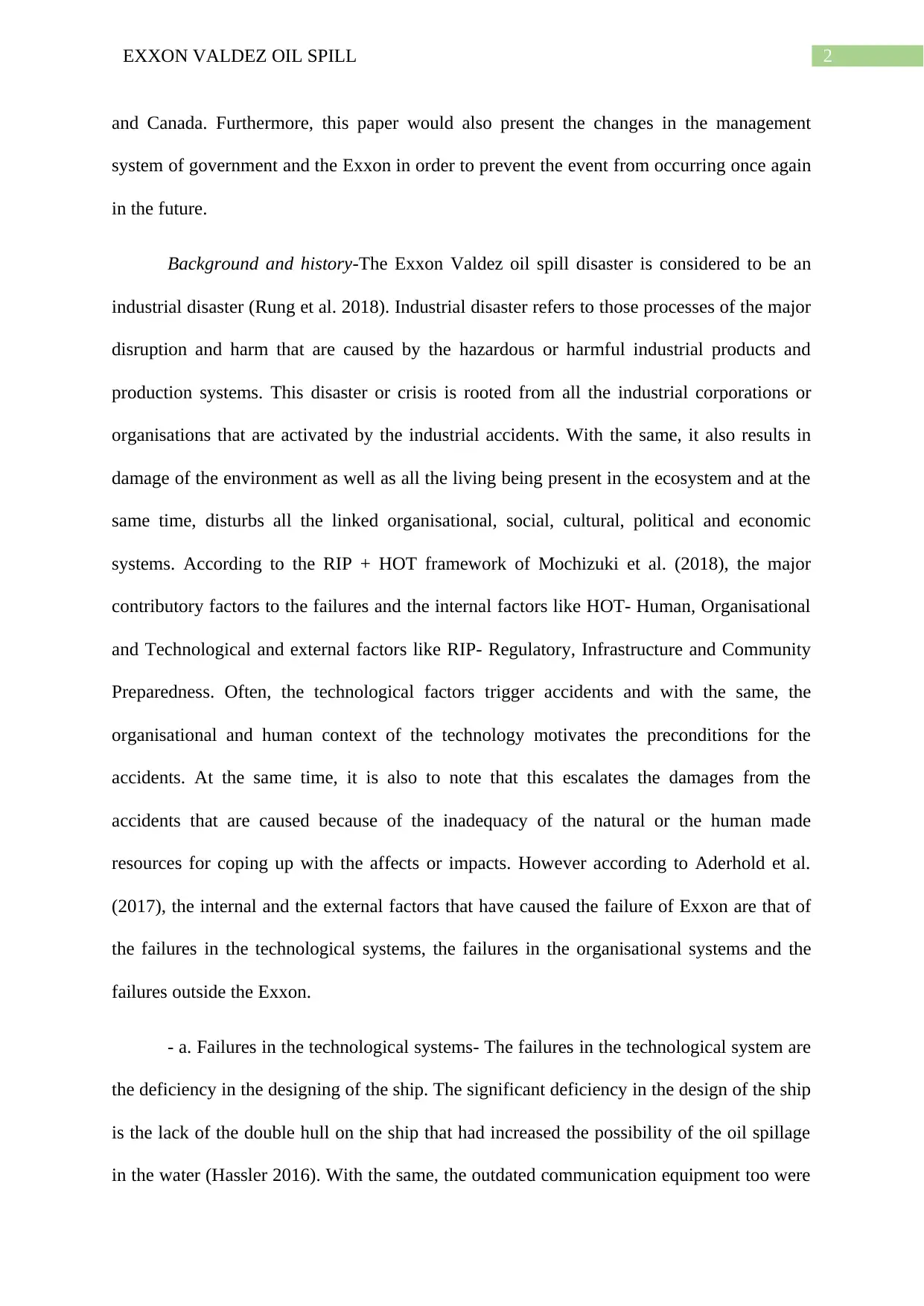
2EXXON VALDEZ OIL SPILL
and Canada. Furthermore, this paper would also present the changes in the management
system of government and the Exxon in order to prevent the event from occurring once again
in the future.
Background and history-The Exxon Valdez oil spill disaster is considered to be an
industrial disaster (Rung et al. 2018). Industrial disaster refers to those processes of the major
disruption and harm that are caused by the hazardous or harmful industrial products and
production systems. This disaster or crisis is rooted from all the industrial corporations or
organisations that are activated by the industrial accidents. With the same, it also results in
damage of the environment as well as all the living being present in the ecosystem and at the
same time, disturbs all the linked organisational, social, cultural, political and economic
systems. According to the RIP + HOT framework of Mochizuki et al. (2018), the major
contributory factors to the failures and the internal factors like HOT- Human, Organisational
and Technological and external factors like RIP- Regulatory, Infrastructure and Community
Preparedness. Often, the technological factors trigger accidents and with the same, the
organisational and human context of the technology motivates the preconditions for the
accidents. At the same time, it is also to note that this escalates the damages from the
accidents that are caused because of the inadequacy of the natural or the human made
resources for coping up with the affects or impacts. However according to Aderhold et al.
(2017), the internal and the external factors that have caused the failure of Exxon are that of
the failures in the technological systems, the failures in the organisational systems and the
failures outside the Exxon.
- a. Failures in the technological systems- The failures in the technological system are
the deficiency in the designing of the ship. The significant deficiency in the design of the ship
is the lack of the double hull on the ship that had increased the possibility of the oil spillage
in the water (Hassler 2016). With the same, the outdated communication equipment too were
and Canada. Furthermore, this paper would also present the changes in the management
system of government and the Exxon in order to prevent the event from occurring once again
in the future.
Background and history-The Exxon Valdez oil spill disaster is considered to be an
industrial disaster (Rung et al. 2018). Industrial disaster refers to those processes of the major
disruption and harm that are caused by the hazardous or harmful industrial products and
production systems. This disaster or crisis is rooted from all the industrial corporations or
organisations that are activated by the industrial accidents. With the same, it also results in
damage of the environment as well as all the living being present in the ecosystem and at the
same time, disturbs all the linked organisational, social, cultural, political and economic
systems. According to the RIP + HOT framework of Mochizuki et al. (2018), the major
contributory factors to the failures and the internal factors like HOT- Human, Organisational
and Technological and external factors like RIP- Regulatory, Infrastructure and Community
Preparedness. Often, the technological factors trigger accidents and with the same, the
organisational and human context of the technology motivates the preconditions for the
accidents. At the same time, it is also to note that this escalates the damages from the
accidents that are caused because of the inadequacy of the natural or the human made
resources for coping up with the affects or impacts. However according to Aderhold et al.
(2017), the internal and the external factors that have caused the failure of Exxon are that of
the failures in the technological systems, the failures in the organisational systems and the
failures outside the Exxon.
- a. Failures in the technological systems- The failures in the technological system are
the deficiency in the designing of the ship. The significant deficiency in the design of the ship
is the lack of the double hull on the ship that had increased the possibility of the oil spillage
in the water (Hassler 2016). With the same, the outdated communication equipment too were
⊘ This is a preview!⊘
Do you want full access?
Subscribe today to unlock all pages.

Trusted by 1+ million students worldwide
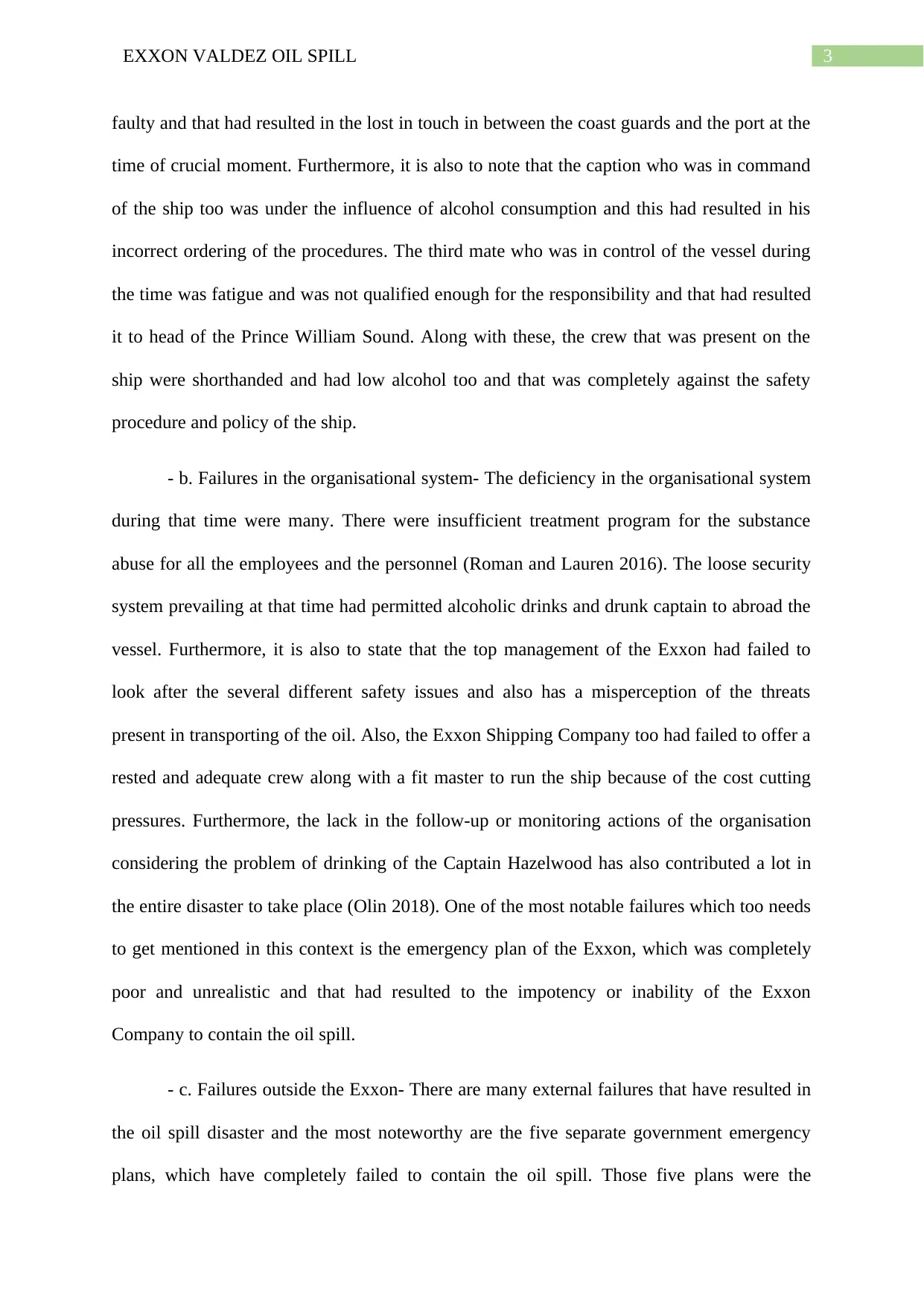
3EXXON VALDEZ OIL SPILL
faulty and that had resulted in the lost in touch in between the coast guards and the port at the
time of crucial moment. Furthermore, it is also to note that the caption who was in command
of the ship too was under the influence of alcohol consumption and this had resulted in his
incorrect ordering of the procedures. The third mate who was in control of the vessel during
the time was fatigue and was not qualified enough for the responsibility and that had resulted
it to head of the Prince William Sound. Along with these, the crew that was present on the
ship were shorthanded and had low alcohol too and that was completely against the safety
procedure and policy of the ship.
- b. Failures in the organisational system- The deficiency in the organisational system
during that time were many. There were insufficient treatment program for the substance
abuse for all the employees and the personnel (Roman and Lauren 2016). The loose security
system prevailing at that time had permitted alcoholic drinks and drunk captain to abroad the
vessel. Furthermore, it is also to state that the top management of the Exxon had failed to
look after the several different safety issues and also has a misperception of the threats
present in transporting of the oil. Also, the Exxon Shipping Company too had failed to offer a
rested and adequate crew along with a fit master to run the ship because of the cost cutting
pressures. Furthermore, the lack in the follow-up or monitoring actions of the organisation
considering the problem of drinking of the Captain Hazelwood has also contributed a lot in
the entire disaster to take place (Olin 2018). One of the most notable failures which too needs
to get mentioned in this context is the emergency plan of the Exxon, which was completely
poor and unrealistic and that had resulted to the impotency or inability of the Exxon
Company to contain the oil spill.
- c. Failures outside the Exxon- There are many external failures that have resulted in
the oil spill disaster and the most noteworthy are the five separate government emergency
plans, which have completely failed to contain the oil spill. Those five plans were the
faulty and that had resulted in the lost in touch in between the coast guards and the port at the
time of crucial moment. Furthermore, it is also to note that the caption who was in command
of the ship too was under the influence of alcohol consumption and this had resulted in his
incorrect ordering of the procedures. The third mate who was in control of the vessel during
the time was fatigue and was not qualified enough for the responsibility and that had resulted
it to head of the Prince William Sound. Along with these, the crew that was present on the
ship were shorthanded and had low alcohol too and that was completely against the safety
procedure and policy of the ship.
- b. Failures in the organisational system- The deficiency in the organisational system
during that time were many. There were insufficient treatment program for the substance
abuse for all the employees and the personnel (Roman and Lauren 2016). The loose security
system prevailing at that time had permitted alcoholic drinks and drunk captain to abroad the
vessel. Furthermore, it is also to state that the top management of the Exxon had failed to
look after the several different safety issues and also has a misperception of the threats
present in transporting of the oil. Also, the Exxon Shipping Company too had failed to offer a
rested and adequate crew along with a fit master to run the ship because of the cost cutting
pressures. Furthermore, the lack in the follow-up or monitoring actions of the organisation
considering the problem of drinking of the Captain Hazelwood has also contributed a lot in
the entire disaster to take place (Olin 2018). One of the most notable failures which too needs
to get mentioned in this context is the emergency plan of the Exxon, which was completely
poor and unrealistic and that had resulted to the impotency or inability of the Exxon
Company to contain the oil spill.
- c. Failures outside the Exxon- There are many external failures that have resulted in
the oil spill disaster and the most noteworthy are the five separate government emergency
plans, which have completely failed to contain the oil spill. Those five plans were the
Paraphrase This Document
Need a fresh take? Get an instant paraphrase of this document with our AI Paraphraser
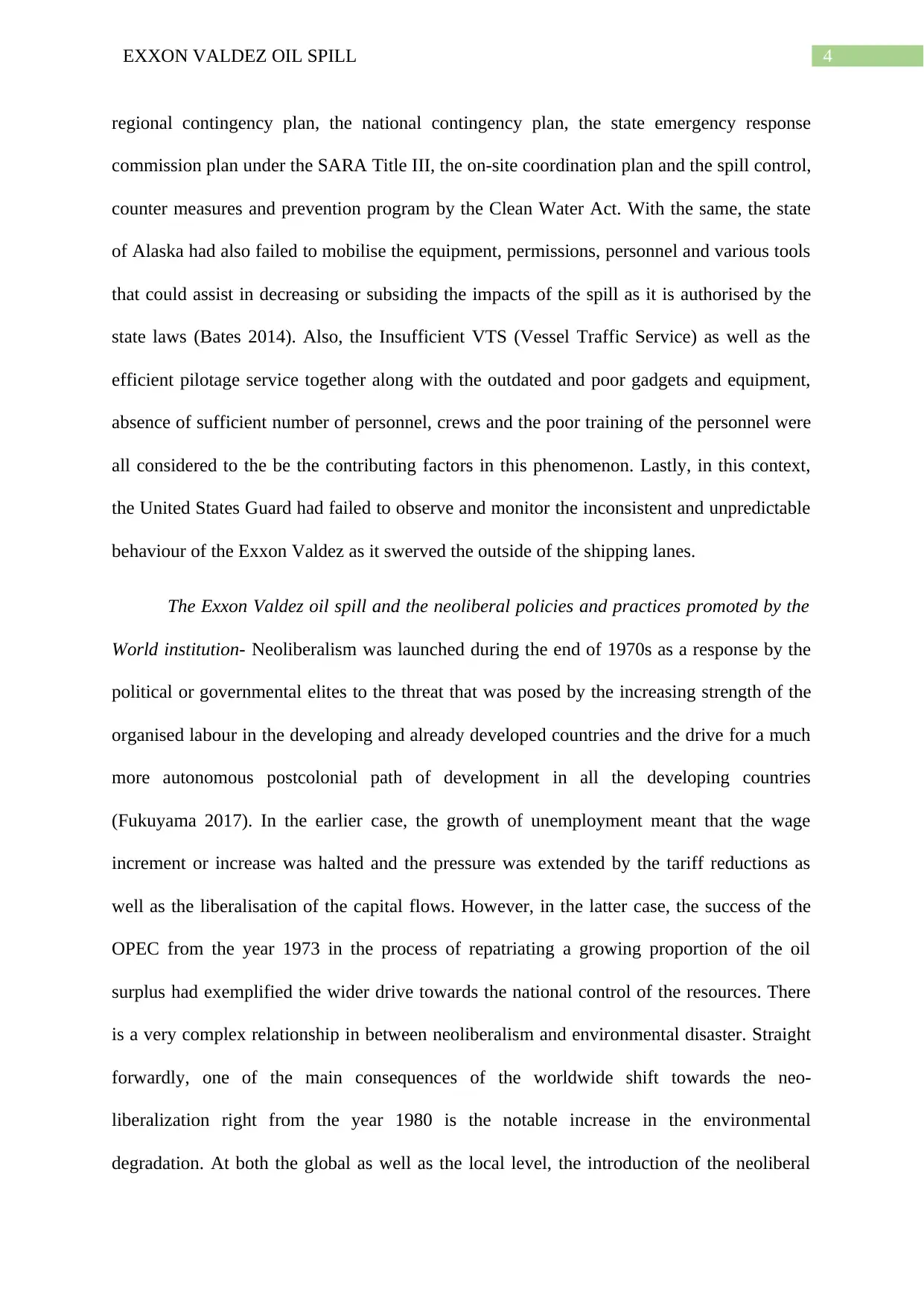
4EXXON VALDEZ OIL SPILL
regional contingency plan, the national contingency plan, the state emergency response
commission plan under the SARA Title III, the on-site coordination plan and the spill control,
counter measures and prevention program by the Clean Water Act. With the same, the state
of Alaska had also failed to mobilise the equipment, permissions, personnel and various tools
that could assist in decreasing or subsiding the impacts of the spill as it is authorised by the
state laws (Bates 2014). Also, the Insufficient VTS (Vessel Traffic Service) as well as the
efficient pilotage service together along with the outdated and poor gadgets and equipment,
absence of sufficient number of personnel, crews and the poor training of the personnel were
all considered to the be the contributing factors in this phenomenon. Lastly, in this context,
the United States Guard had failed to observe and monitor the inconsistent and unpredictable
behaviour of the Exxon Valdez as it swerved the outside of the shipping lanes.
The Exxon Valdez oil spill and the neoliberal policies and practices promoted by the
World institution- Neoliberalism was launched during the end of 1970s as a response by the
political or governmental elites to the threat that was posed by the increasing strength of the
organised labour in the developing and already developed countries and the drive for a much
more autonomous postcolonial path of development in all the developing countries
(Fukuyama 2017). In the earlier case, the growth of unemployment meant that the wage
increment or increase was halted and the pressure was extended by the tariff reductions as
well as the liberalisation of the capital flows. However, in the latter case, the success of the
OPEC from the year 1973 in the process of repatriating a growing proportion of the oil
surplus had exemplified the wider drive towards the national control of the resources. There
is a very complex relationship in between neoliberalism and environmental disaster. Straight
forwardly, one of the main consequences of the worldwide shift towards the neo-
liberalization right from the year 1980 is the notable increase in the environmental
degradation. At both the global as well as the local level, the introduction of the neoliberal
regional contingency plan, the national contingency plan, the state emergency response
commission plan under the SARA Title III, the on-site coordination plan and the spill control,
counter measures and prevention program by the Clean Water Act. With the same, the state
of Alaska had also failed to mobilise the equipment, permissions, personnel and various tools
that could assist in decreasing or subsiding the impacts of the spill as it is authorised by the
state laws (Bates 2014). Also, the Insufficient VTS (Vessel Traffic Service) as well as the
efficient pilotage service together along with the outdated and poor gadgets and equipment,
absence of sufficient number of personnel, crews and the poor training of the personnel were
all considered to the be the contributing factors in this phenomenon. Lastly, in this context,
the United States Guard had failed to observe and monitor the inconsistent and unpredictable
behaviour of the Exxon Valdez as it swerved the outside of the shipping lanes.
The Exxon Valdez oil spill and the neoliberal policies and practices promoted by the
World institution- Neoliberalism was launched during the end of 1970s as a response by the
political or governmental elites to the threat that was posed by the increasing strength of the
organised labour in the developing and already developed countries and the drive for a much
more autonomous postcolonial path of development in all the developing countries
(Fukuyama 2017). In the earlier case, the growth of unemployment meant that the wage
increment or increase was halted and the pressure was extended by the tariff reductions as
well as the liberalisation of the capital flows. However, in the latter case, the success of the
OPEC from the year 1973 in the process of repatriating a growing proportion of the oil
surplus had exemplified the wider drive towards the national control of the resources. There
is a very complex relationship in between neoliberalism and environmental disaster. Straight
forwardly, one of the main consequences of the worldwide shift towards the neo-
liberalization right from the year 1980 is the notable increase in the environmental
degradation. At both the global as well as the local level, the introduction of the neoliberal
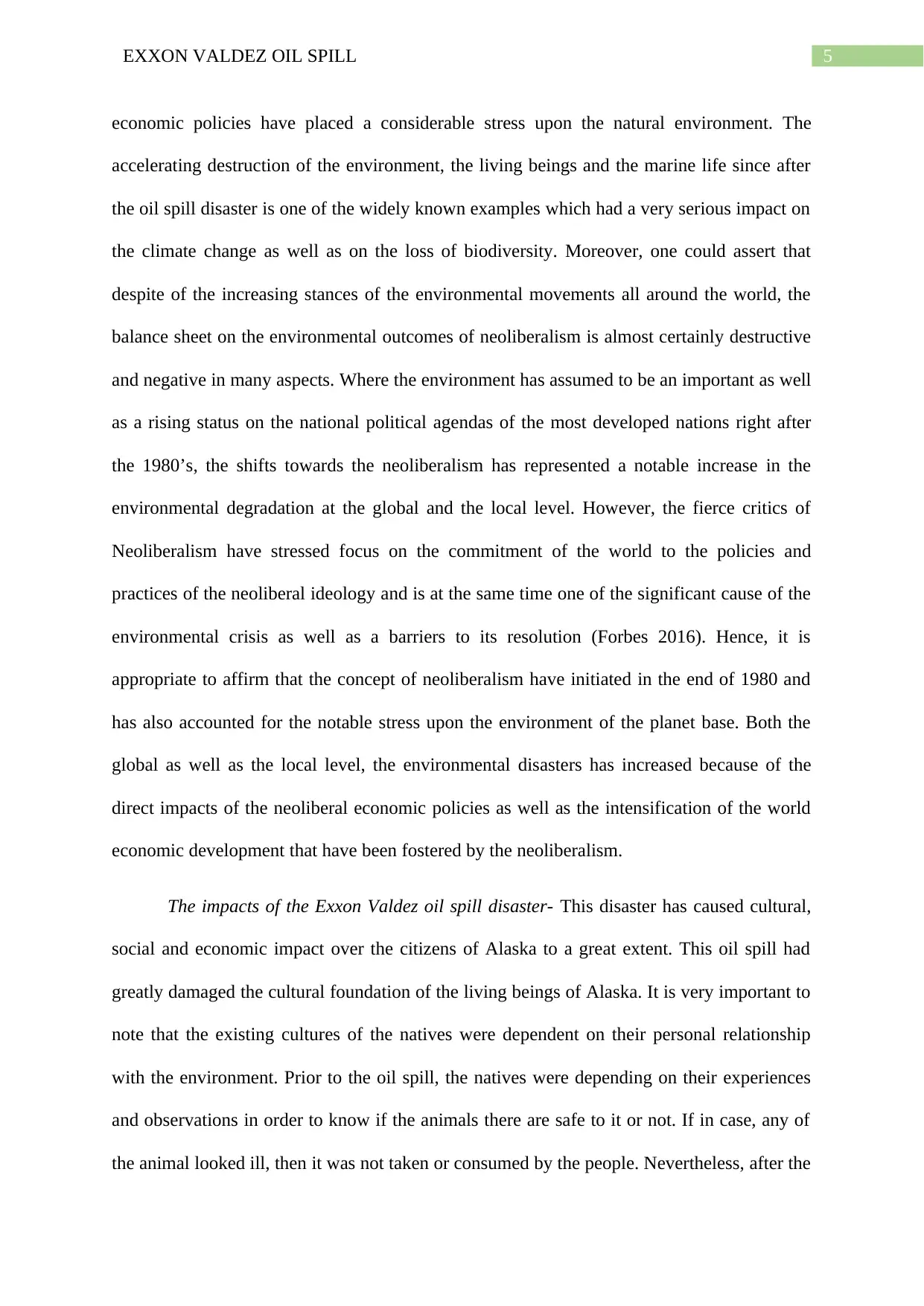
5EXXON VALDEZ OIL SPILL
economic policies have placed a considerable stress upon the natural environment. The
accelerating destruction of the environment, the living beings and the marine life since after
the oil spill disaster is one of the widely known examples which had a very serious impact on
the climate change as well as on the loss of biodiversity. Moreover, one could assert that
despite of the increasing stances of the environmental movements all around the world, the
balance sheet on the environmental outcomes of neoliberalism is almost certainly destructive
and negative in many aspects. Where the environment has assumed to be an important as well
as a rising status on the national political agendas of the most developed nations right after
the 1980’s, the shifts towards the neoliberalism has represented a notable increase in the
environmental degradation at the global and the local level. However, the fierce critics of
Neoliberalism have stressed focus on the commitment of the world to the policies and
practices of the neoliberal ideology and is at the same time one of the significant cause of the
environmental crisis as well as a barriers to its resolution (Forbes 2016). Hence, it is
appropriate to affirm that the concept of neoliberalism have initiated in the end of 1980 and
has also accounted for the notable stress upon the environment of the planet base. Both the
global as well as the local level, the environmental disasters has increased because of the
direct impacts of the neoliberal economic policies as well as the intensification of the world
economic development that have been fostered by the neoliberalism.
The impacts of the Exxon Valdez oil spill disaster- This disaster has caused cultural,
social and economic impact over the citizens of Alaska to a great extent. This oil spill had
greatly damaged the cultural foundation of the living beings of Alaska. It is very important to
note that the existing cultures of the natives were dependent on their personal relationship
with the environment. Prior to the oil spill, the natives were depending on their experiences
and observations in order to know if the animals there are safe to it or not. If in case, any of
the animal looked ill, then it was not taken or consumed by the people. Nevertheless, after the
economic policies have placed a considerable stress upon the natural environment. The
accelerating destruction of the environment, the living beings and the marine life since after
the oil spill disaster is one of the widely known examples which had a very serious impact on
the climate change as well as on the loss of biodiversity. Moreover, one could assert that
despite of the increasing stances of the environmental movements all around the world, the
balance sheet on the environmental outcomes of neoliberalism is almost certainly destructive
and negative in many aspects. Where the environment has assumed to be an important as well
as a rising status on the national political agendas of the most developed nations right after
the 1980’s, the shifts towards the neoliberalism has represented a notable increase in the
environmental degradation at the global and the local level. However, the fierce critics of
Neoliberalism have stressed focus on the commitment of the world to the policies and
practices of the neoliberal ideology and is at the same time one of the significant cause of the
environmental crisis as well as a barriers to its resolution (Forbes 2016). Hence, it is
appropriate to affirm that the concept of neoliberalism have initiated in the end of 1980 and
has also accounted for the notable stress upon the environment of the planet base. Both the
global as well as the local level, the environmental disasters has increased because of the
direct impacts of the neoliberal economic policies as well as the intensification of the world
economic development that have been fostered by the neoliberalism.
The impacts of the Exxon Valdez oil spill disaster- This disaster has caused cultural,
social and economic impact over the citizens of Alaska to a great extent. This oil spill had
greatly damaged the cultural foundation of the living beings of Alaska. It is very important to
note that the existing cultures of the natives were dependent on their personal relationship
with the environment. Prior to the oil spill, the natives were depending on their experiences
and observations in order to know if the animals there are safe to it or not. If in case, any of
the animal looked ill, then it was not taken or consumed by the people. Nevertheless, after the
⊘ This is a preview!⊘
Do you want full access?
Subscribe today to unlock all pages.

Trusted by 1+ million students worldwide
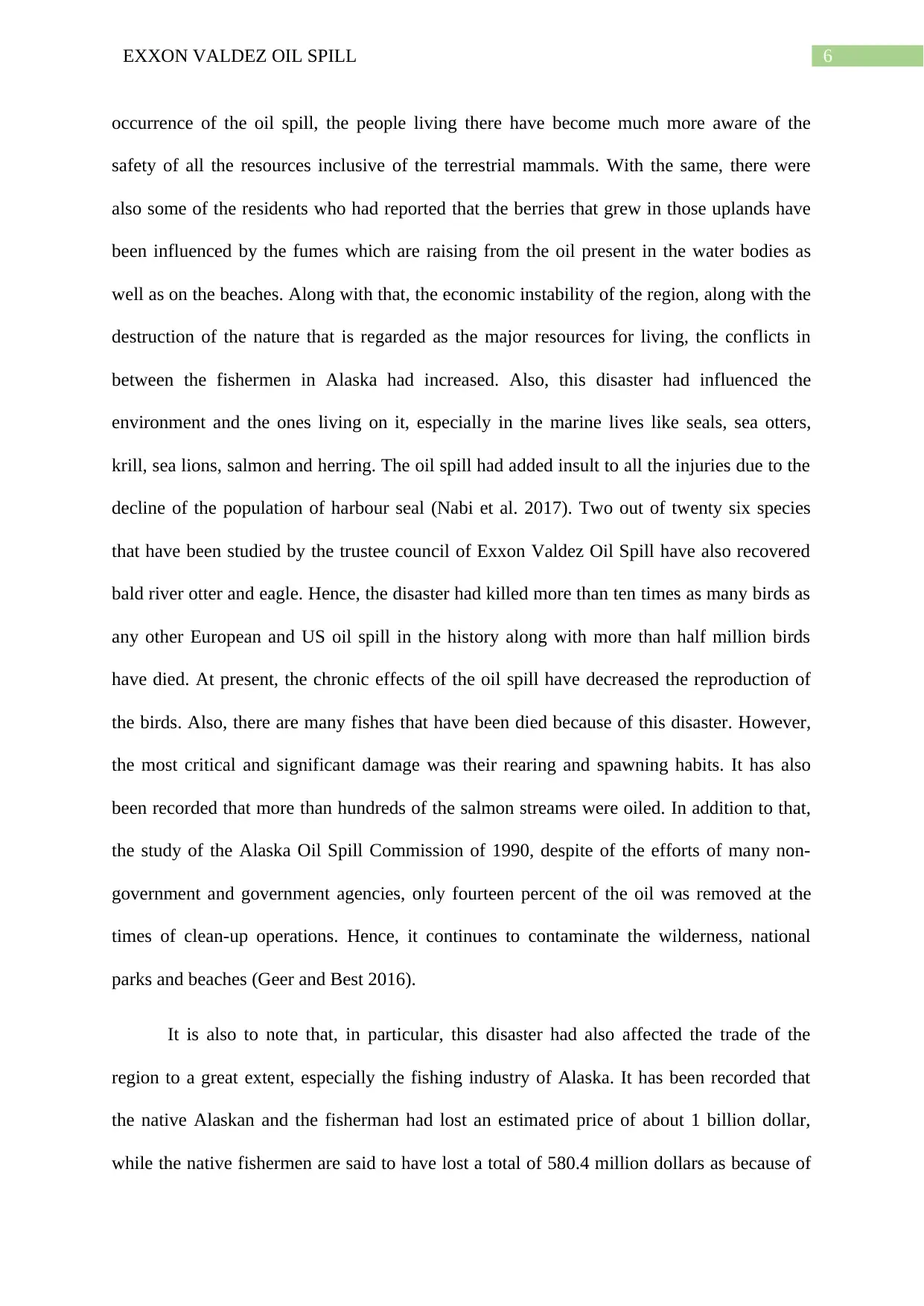
6EXXON VALDEZ OIL SPILL
occurrence of the oil spill, the people living there have become much more aware of the
safety of all the resources inclusive of the terrestrial mammals. With the same, there were
also some of the residents who had reported that the berries that grew in those uplands have
been influenced by the fumes which are raising from the oil present in the water bodies as
well as on the beaches. Along with that, the economic instability of the region, along with the
destruction of the nature that is regarded as the major resources for living, the conflicts in
between the fishermen in Alaska had increased. Also, this disaster had influenced the
environment and the ones living on it, especially in the marine lives like seals, sea otters,
krill, sea lions, salmon and herring. The oil spill had added insult to all the injuries due to the
decline of the population of harbour seal (Nabi et al. 2017). Two out of twenty six species
that have been studied by the trustee council of Exxon Valdez Oil Spill have also recovered
bald river otter and eagle. Hence, the disaster had killed more than ten times as many birds as
any other European and US oil spill in the history along with more than half million birds
have died. At present, the chronic effects of the oil spill have decreased the reproduction of
the birds. Also, there are many fishes that have been died because of this disaster. However,
the most critical and significant damage was their rearing and spawning habits. It has also
been recorded that more than hundreds of the salmon streams were oiled. In addition to that,
the study of the Alaska Oil Spill Commission of 1990, despite of the efforts of many non-
government and government agencies, only fourteen percent of the oil was removed at the
times of clean-up operations. Hence, it continues to contaminate the wilderness, national
parks and beaches (Geer and Best 2016).
It is also to note that, in particular, this disaster had also affected the trade of the
region to a great extent, especially the fishing industry of Alaska. It has been recorded that
the native Alaskan and the fisherman had lost an estimated price of about 1 billion dollar,
while the native fishermen are said to have lost a total of 580.4 million dollars as because of
occurrence of the oil spill, the people living there have become much more aware of the
safety of all the resources inclusive of the terrestrial mammals. With the same, there were
also some of the residents who had reported that the berries that grew in those uplands have
been influenced by the fumes which are raising from the oil present in the water bodies as
well as on the beaches. Along with that, the economic instability of the region, along with the
destruction of the nature that is regarded as the major resources for living, the conflicts in
between the fishermen in Alaska had increased. Also, this disaster had influenced the
environment and the ones living on it, especially in the marine lives like seals, sea otters,
krill, sea lions, salmon and herring. The oil spill had added insult to all the injuries due to the
decline of the population of harbour seal (Nabi et al. 2017). Two out of twenty six species
that have been studied by the trustee council of Exxon Valdez Oil Spill have also recovered
bald river otter and eagle. Hence, the disaster had killed more than ten times as many birds as
any other European and US oil spill in the history along with more than half million birds
have died. At present, the chronic effects of the oil spill have decreased the reproduction of
the birds. Also, there are many fishes that have been died because of this disaster. However,
the most critical and significant damage was their rearing and spawning habits. It has also
been recorded that more than hundreds of the salmon streams were oiled. In addition to that,
the study of the Alaska Oil Spill Commission of 1990, despite of the efforts of many non-
government and government agencies, only fourteen percent of the oil was removed at the
times of clean-up operations. Hence, it continues to contaminate the wilderness, national
parks and beaches (Geer and Best 2016).
It is also to note that, in particular, this disaster had also affected the trade of the
region to a great extent, especially the fishing industry of Alaska. It has been recorded that
the native Alaskan and the fisherman had lost an estimated price of about 1 billion dollar,
while the native fishermen are said to have lost a total of 580.4 million dollars as because of
Paraphrase This Document
Need a fresh take? Get an instant paraphrase of this document with our AI Paraphraser
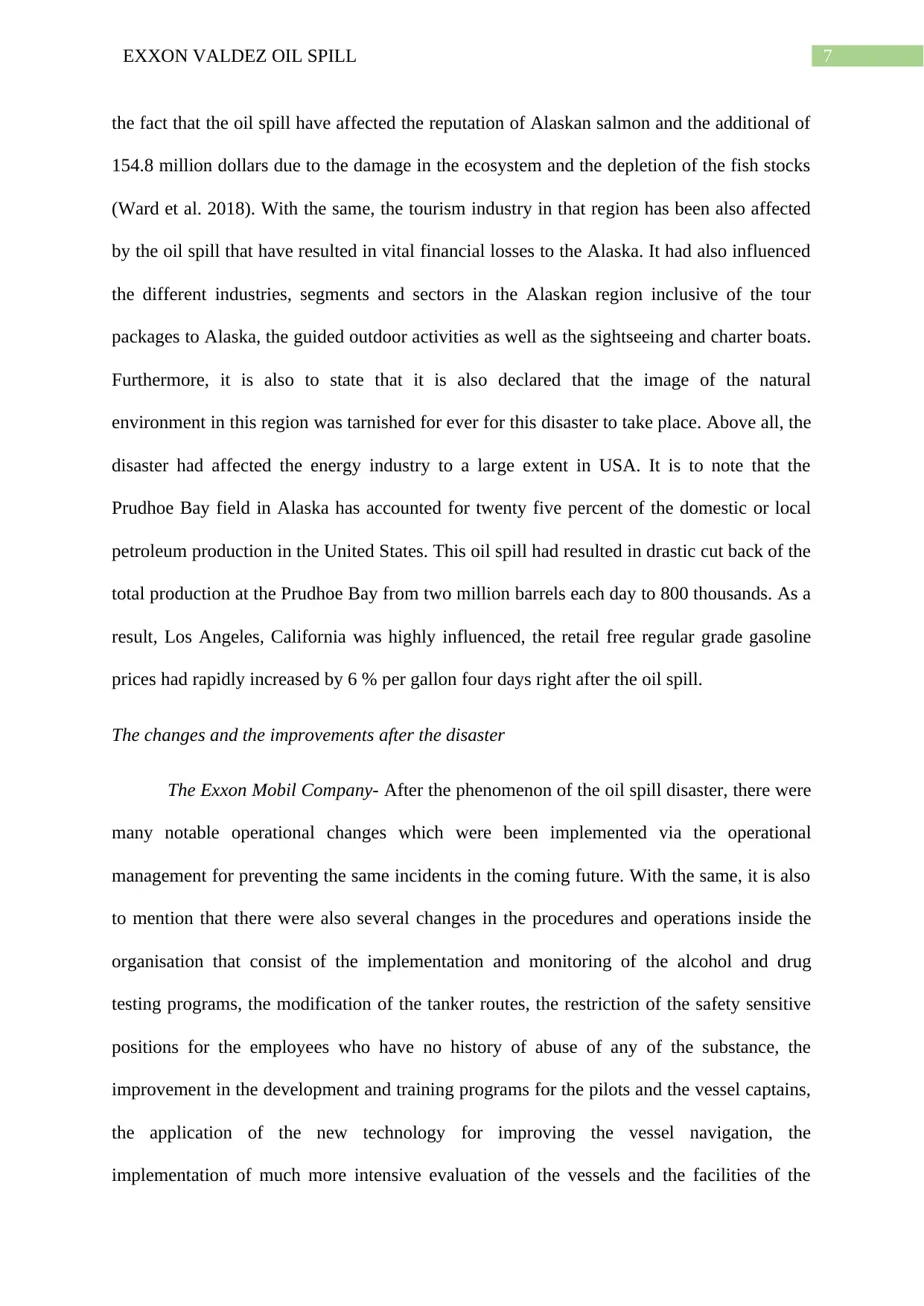
7EXXON VALDEZ OIL SPILL
the fact that the oil spill have affected the reputation of Alaskan salmon and the additional of
154.8 million dollars due to the damage in the ecosystem and the depletion of the fish stocks
(Ward et al. 2018). With the same, the tourism industry in that region has been also affected
by the oil spill that have resulted in vital financial losses to the Alaska. It had also influenced
the different industries, segments and sectors in the Alaskan region inclusive of the tour
packages to Alaska, the guided outdoor activities as well as the sightseeing and charter boats.
Furthermore, it is also to state that it is also declared that the image of the natural
environment in this region was tarnished for ever for this disaster to take place. Above all, the
disaster had affected the energy industry to a large extent in USA. It is to note that the
Prudhoe Bay field in Alaska has accounted for twenty five percent of the domestic or local
petroleum production in the United States. This oil spill had resulted in drastic cut back of the
total production at the Prudhoe Bay from two million barrels each day to 800 thousands. As a
result, Los Angeles, California was highly influenced, the retail free regular grade gasoline
prices had rapidly increased by 6 % per gallon four days right after the oil spill.
The changes and the improvements after the disaster
The Exxon Mobil Company- After the phenomenon of the oil spill disaster, there were
many notable operational changes which were been implemented via the operational
management for preventing the same incidents in the coming future. With the same, it is also
to mention that there were also several changes in the procedures and operations inside the
organisation that consist of the implementation and monitoring of the alcohol and drug
testing programs, the modification of the tanker routes, the restriction of the safety sensitive
positions for the employees who have no history of abuse of any of the substance, the
improvement in the development and training programs for the pilots and the vessel captains,
the application of the new technology for improving the vessel navigation, the
implementation of much more intensive evaluation of the vessels and the facilities of the
the fact that the oil spill have affected the reputation of Alaskan salmon and the additional of
154.8 million dollars due to the damage in the ecosystem and the depletion of the fish stocks
(Ward et al. 2018). With the same, the tourism industry in that region has been also affected
by the oil spill that have resulted in vital financial losses to the Alaska. It had also influenced
the different industries, segments and sectors in the Alaskan region inclusive of the tour
packages to Alaska, the guided outdoor activities as well as the sightseeing and charter boats.
Furthermore, it is also to state that it is also declared that the image of the natural
environment in this region was tarnished for ever for this disaster to take place. Above all, the
disaster had affected the energy industry to a large extent in USA. It is to note that the
Prudhoe Bay field in Alaska has accounted for twenty five percent of the domestic or local
petroleum production in the United States. This oil spill had resulted in drastic cut back of the
total production at the Prudhoe Bay from two million barrels each day to 800 thousands. As a
result, Los Angeles, California was highly influenced, the retail free regular grade gasoline
prices had rapidly increased by 6 % per gallon four days right after the oil spill.
The changes and the improvements after the disaster
The Exxon Mobil Company- After the phenomenon of the oil spill disaster, there were
many notable operational changes which were been implemented via the operational
management for preventing the same incidents in the coming future. With the same, it is also
to mention that there were also several changes in the procedures and operations inside the
organisation that consist of the implementation and monitoring of the alcohol and drug
testing programs, the modification of the tanker routes, the restriction of the safety sensitive
positions for the employees who have no history of abuse of any of the substance, the
improvement in the development and training programs for the pilots and the vessel captains,
the application of the new technology for improving the vessel navigation, the
implementation of much more intensive evaluation of the vessels and the facilities of the
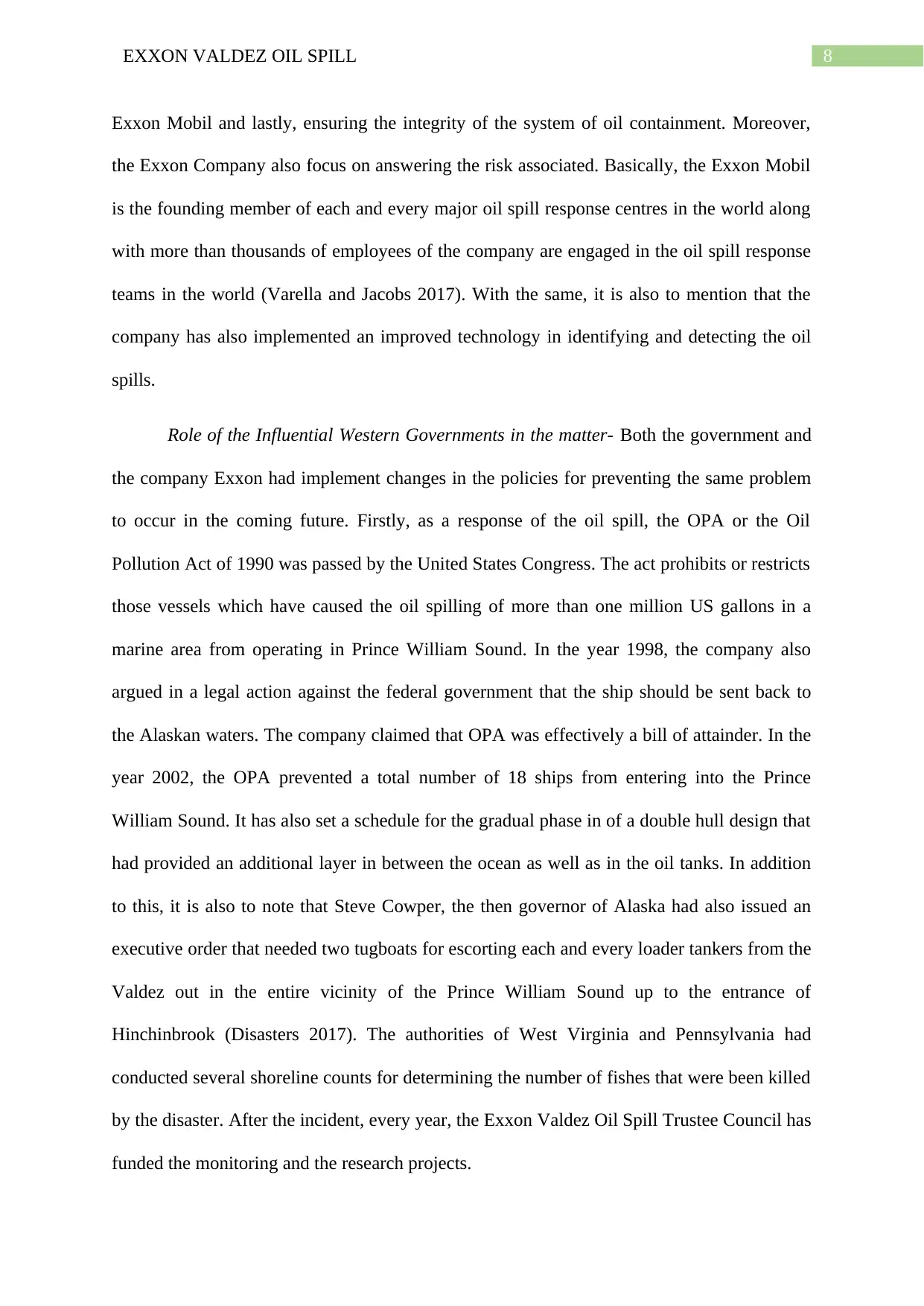
8EXXON VALDEZ OIL SPILL
Exxon Mobil and lastly, ensuring the integrity of the system of oil containment. Moreover,
the Exxon Company also focus on answering the risk associated. Basically, the Exxon Mobil
is the founding member of each and every major oil spill response centres in the world along
with more than thousands of employees of the company are engaged in the oil spill response
teams in the world (Varella and Jacobs 2017). With the same, it is also to mention that the
company has also implemented an improved technology in identifying and detecting the oil
spills.
Role of the Influential Western Governments in the matter- Both the government and
the company Exxon had implement changes in the policies for preventing the same problem
to occur in the coming future. Firstly, as a response of the oil spill, the OPA or the Oil
Pollution Act of 1990 was passed by the United States Congress. The act prohibits or restricts
those vessels which have caused the oil spilling of more than one million US gallons in a
marine area from operating in Prince William Sound. In the year 1998, the company also
argued in a legal action against the federal government that the ship should be sent back to
the Alaskan waters. The company claimed that OPA was effectively a bill of attainder. In the
year 2002, the OPA prevented a total number of 18 ships from entering into the Prince
William Sound. It has also set a schedule for the gradual phase in of a double hull design that
had provided an additional layer in between the ocean as well as in the oil tanks. In addition
to this, it is also to note that Steve Cowper, the then governor of Alaska had also issued an
executive order that needed two tugboats for escorting each and every loader tankers from the
Valdez out in the entire vicinity of the Prince William Sound up to the entrance of
Hinchinbrook (Disasters 2017). The authorities of West Virginia and Pennsylvania had
conducted several shoreline counts for determining the number of fishes that were been killed
by the disaster. After the incident, every year, the Exxon Valdez Oil Spill Trustee Council has
funded the monitoring and the research projects.
Exxon Mobil and lastly, ensuring the integrity of the system of oil containment. Moreover,
the Exxon Company also focus on answering the risk associated. Basically, the Exxon Mobil
is the founding member of each and every major oil spill response centres in the world along
with more than thousands of employees of the company are engaged in the oil spill response
teams in the world (Varella and Jacobs 2017). With the same, it is also to mention that the
company has also implemented an improved technology in identifying and detecting the oil
spills.
Role of the Influential Western Governments in the matter- Both the government and
the company Exxon had implement changes in the policies for preventing the same problem
to occur in the coming future. Firstly, as a response of the oil spill, the OPA or the Oil
Pollution Act of 1990 was passed by the United States Congress. The act prohibits or restricts
those vessels which have caused the oil spilling of more than one million US gallons in a
marine area from operating in Prince William Sound. In the year 1998, the company also
argued in a legal action against the federal government that the ship should be sent back to
the Alaskan waters. The company claimed that OPA was effectively a bill of attainder. In the
year 2002, the OPA prevented a total number of 18 ships from entering into the Prince
William Sound. It has also set a schedule for the gradual phase in of a double hull design that
had provided an additional layer in between the ocean as well as in the oil tanks. In addition
to this, it is also to note that Steve Cowper, the then governor of Alaska had also issued an
executive order that needed two tugboats for escorting each and every loader tankers from the
Valdez out in the entire vicinity of the Prince William Sound up to the entrance of
Hinchinbrook (Disasters 2017). The authorities of West Virginia and Pennsylvania had
conducted several shoreline counts for determining the number of fishes that were been killed
by the disaster. After the incident, every year, the Exxon Valdez Oil Spill Trustee Council has
funded the monitoring and the research projects.
⊘ This is a preview!⊘
Do you want full access?
Subscribe today to unlock all pages.

Trusted by 1+ million students worldwide
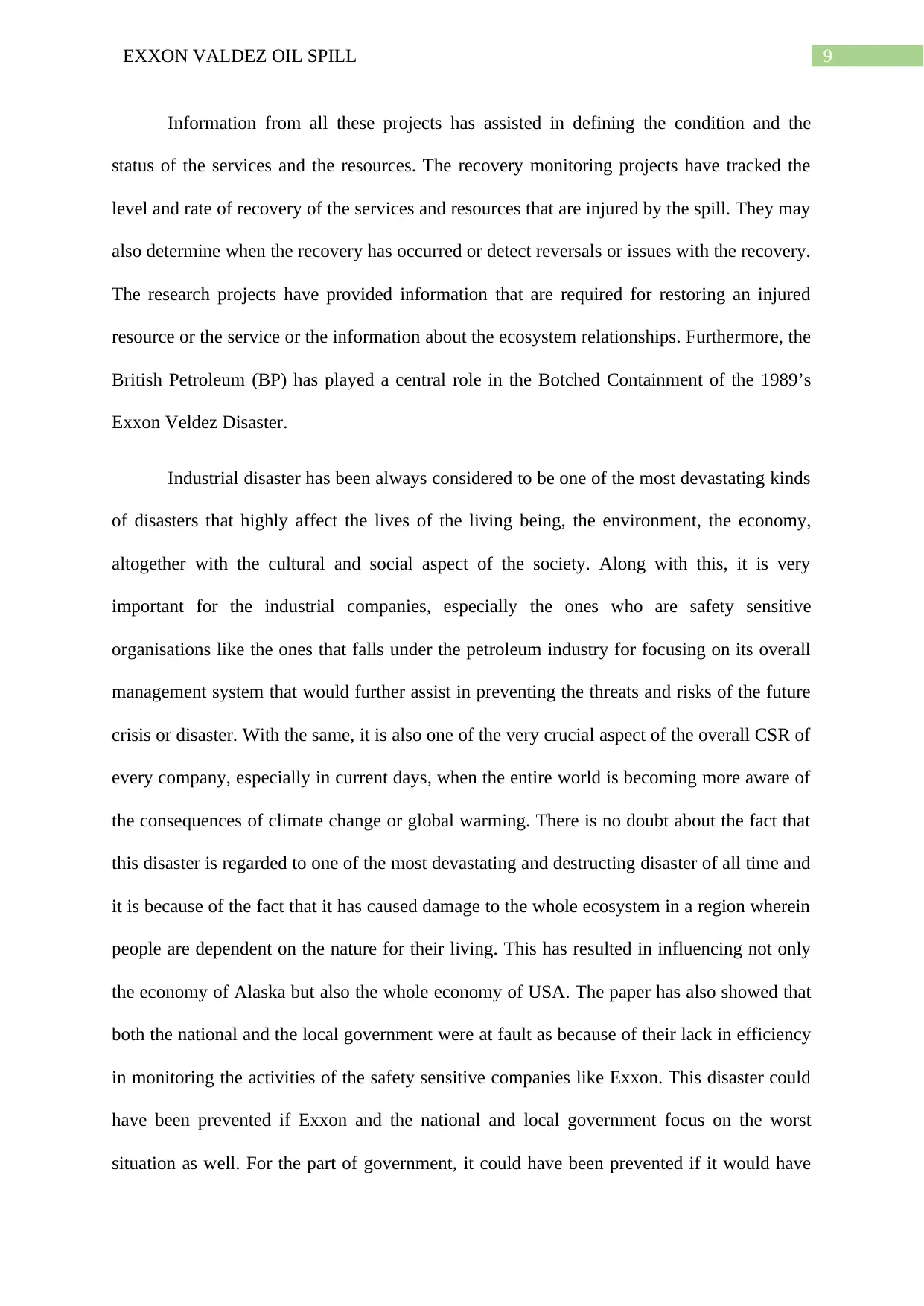
9EXXON VALDEZ OIL SPILL
Information from all these projects has assisted in defining the condition and the
status of the services and the resources. The recovery monitoring projects have tracked the
level and rate of recovery of the services and resources that are injured by the spill. They may
also determine when the recovery has occurred or detect reversals or issues with the recovery.
The research projects have provided information that are required for restoring an injured
resource or the service or the information about the ecosystem relationships. Furthermore, the
British Petroleum (BP) has played a central role in the Botched Containment of the 1989’s
Exxon Veldez Disaster.
Industrial disaster has been always considered to be one of the most devastating kinds
of disasters that highly affect the lives of the living being, the environment, the economy,
altogether with the cultural and social aspect of the society. Along with this, it is very
important for the industrial companies, especially the ones who are safety sensitive
organisations like the ones that falls under the petroleum industry for focusing on its overall
management system that would further assist in preventing the threats and risks of the future
crisis or disaster. With the same, it is also one of the very crucial aspect of the overall CSR of
every company, especially in current days, when the entire world is becoming more aware of
the consequences of climate change or global warming. There is no doubt about the fact that
this disaster is regarded to one of the most devastating and destructing disaster of all time and
it is because of the fact that it has caused damage to the whole ecosystem in a region wherein
people are dependent on the nature for their living. This has resulted in influencing not only
the economy of Alaska but also the whole economy of USA. The paper has also showed that
both the national and the local government were at fault as because of their lack in efficiency
in monitoring the activities of the safety sensitive companies like Exxon. This disaster could
have been prevented if Exxon and the national and local government focus on the worst
situation as well. For the part of government, it could have been prevented if it would have
Information from all these projects has assisted in defining the condition and the
status of the services and the resources. The recovery monitoring projects have tracked the
level and rate of recovery of the services and resources that are injured by the spill. They may
also determine when the recovery has occurred or detect reversals or issues with the recovery.
The research projects have provided information that are required for restoring an injured
resource or the service or the information about the ecosystem relationships. Furthermore, the
British Petroleum (BP) has played a central role in the Botched Containment of the 1989’s
Exxon Veldez Disaster.
Industrial disaster has been always considered to be one of the most devastating kinds
of disasters that highly affect the lives of the living being, the environment, the economy,
altogether with the cultural and social aspect of the society. Along with this, it is very
important for the industrial companies, especially the ones who are safety sensitive
organisations like the ones that falls under the petroleum industry for focusing on its overall
management system that would further assist in preventing the threats and risks of the future
crisis or disaster. With the same, it is also one of the very crucial aspect of the overall CSR of
every company, especially in current days, when the entire world is becoming more aware of
the consequences of climate change or global warming. There is no doubt about the fact that
this disaster is regarded to one of the most devastating and destructing disaster of all time and
it is because of the fact that it has caused damage to the whole ecosystem in a region wherein
people are dependent on the nature for their living. This has resulted in influencing not only
the economy of Alaska but also the whole economy of USA. The paper has also showed that
both the national and the local government were at fault as because of their lack in efficiency
in monitoring the activities of the safety sensitive companies like Exxon. This disaster could
have been prevented if Exxon and the national and local government focus on the worst
situation as well. For the part of government, it could have been prevented if it would have
Paraphrase This Document
Need a fresh take? Get an instant paraphrase of this document with our AI Paraphraser
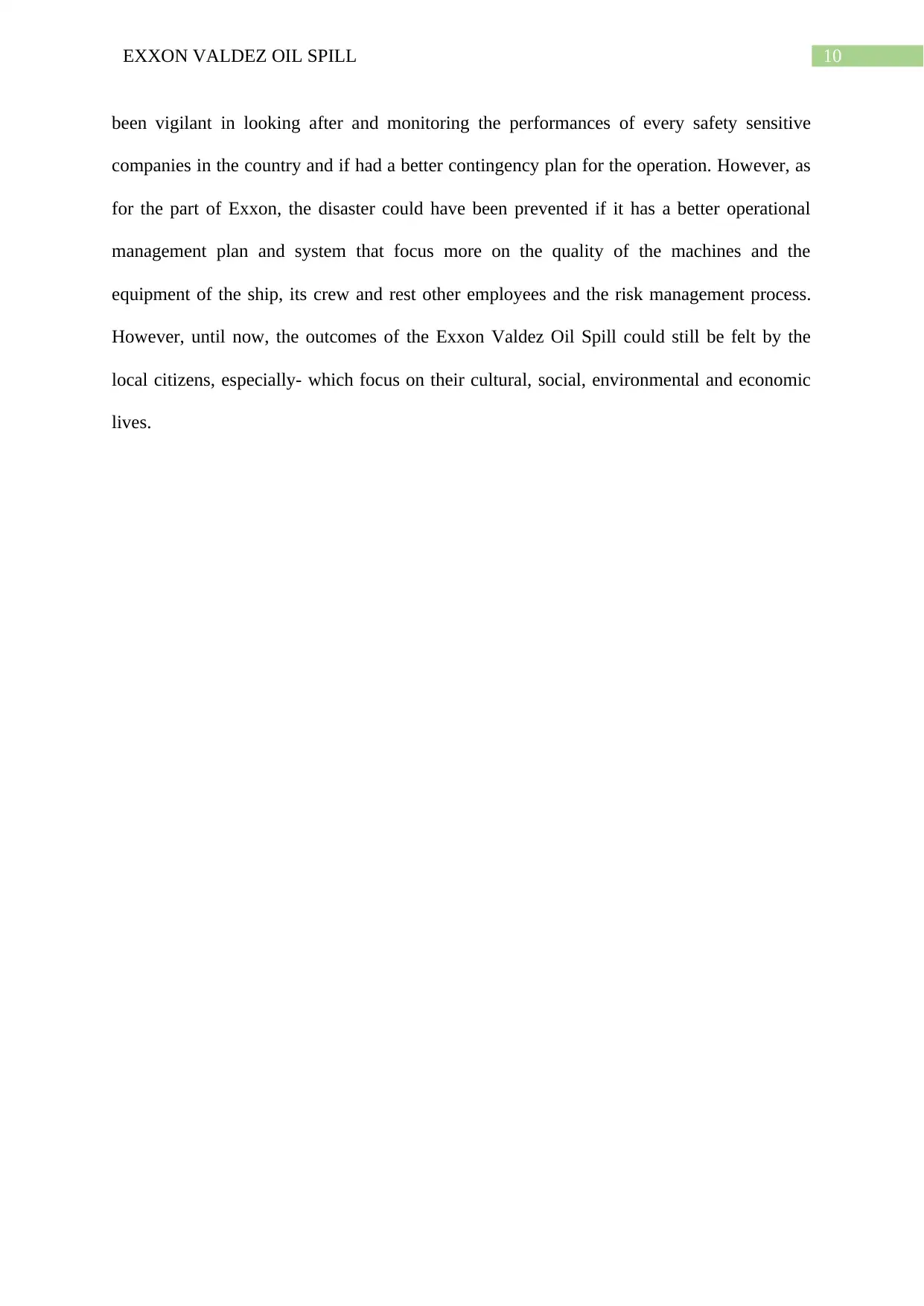
10EXXON VALDEZ OIL SPILL
been vigilant in looking after and monitoring the performances of every safety sensitive
companies in the country and if had a better contingency plan for the operation. However, as
for the part of Exxon, the disaster could have been prevented if it has a better operational
management plan and system that focus more on the quality of the machines and the
equipment of the ship, its crew and rest other employees and the risk management process.
However, until now, the outcomes of the Exxon Valdez Oil Spill could still be felt by the
local citizens, especially- which focus on their cultural, social, environmental and economic
lives.
been vigilant in looking after and monitoring the performances of every safety sensitive
companies in the country and if had a better contingency plan for the operation. However, as
for the part of Exxon, the disaster could have been prevented if it has a better operational
management plan and system that focus more on the quality of the machines and the
equipment of the ship, its crew and rest other employees and the risk management process.
However, until now, the outcomes of the Exxon Valdez Oil Spill could still be felt by the
local citizens, especially- which focus on their cultural, social, environmental and economic
lives.
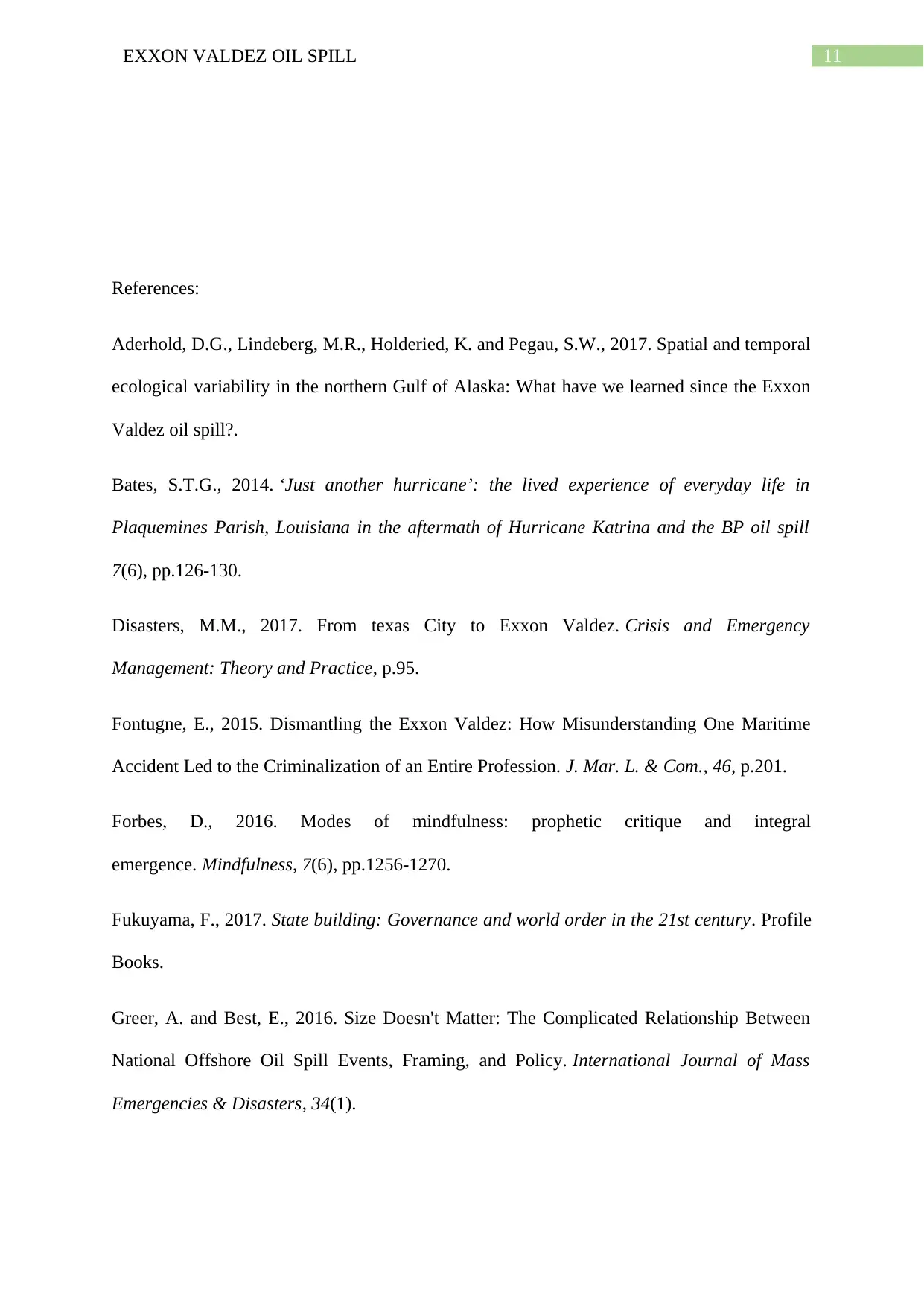
11EXXON VALDEZ OIL SPILL
References:
Aderhold, D.G., Lindeberg, M.R., Holderied, K. and Pegau, S.W., 2017. Spatial and temporal
ecological variability in the northern Gulf of Alaska: What have we learned since the Exxon
Valdez oil spill?.
Bates, S.T.G., 2014. ‘Just another hurricane’: the lived experience of everyday life in
Plaquemines Parish, Louisiana in the aftermath of Hurricane Katrina and the BP oil spill
7(6), pp.126-130.
Disasters, M.M., 2017. From texas City to Exxon Valdez. Crisis and Emergency
Management: Theory and Practice, p.95.
Fontugne, E., 2015. Dismantling the Exxon Valdez: How Misunderstanding One Maritime
Accident Led to the Criminalization of an Entire Profession. J. Mar. L. & Com., 46, p.201.
Forbes, D., 2016. Modes of mindfulness: prophetic critique and integral
emergence. Mindfulness, 7(6), pp.1256-1270.
Fukuyama, F., 2017. State building: Governance and world order in the 21st century. Profile
Books.
Greer, A. and Best, E., 2016. Size Doesn't Matter: The Complicated Relationship Between
National Offshore Oil Spill Events, Framing, and Policy. International Journal of Mass
Emergencies & Disasters, 34(1).
References:
Aderhold, D.G., Lindeberg, M.R., Holderied, K. and Pegau, S.W., 2017. Spatial and temporal
ecological variability in the northern Gulf of Alaska: What have we learned since the Exxon
Valdez oil spill?.
Bates, S.T.G., 2014. ‘Just another hurricane’: the lived experience of everyday life in
Plaquemines Parish, Louisiana in the aftermath of Hurricane Katrina and the BP oil spill
7(6), pp.126-130.
Disasters, M.M., 2017. From texas City to Exxon Valdez. Crisis and Emergency
Management: Theory and Practice, p.95.
Fontugne, E., 2015. Dismantling the Exxon Valdez: How Misunderstanding One Maritime
Accident Led to the Criminalization of an Entire Profession. J. Mar. L. & Com., 46, p.201.
Forbes, D., 2016. Modes of mindfulness: prophetic critique and integral
emergence. Mindfulness, 7(6), pp.1256-1270.
Fukuyama, F., 2017. State building: Governance and world order in the 21st century. Profile
Books.
Greer, A. and Best, E., 2016. Size Doesn't Matter: The Complicated Relationship Between
National Offshore Oil Spill Events, Framing, and Policy. International Journal of Mass
Emergencies & Disasters, 34(1).
⊘ This is a preview!⊘
Do you want full access?
Subscribe today to unlock all pages.

Trusted by 1+ million students worldwide
1 out of 14
Related Documents
Your All-in-One AI-Powered Toolkit for Academic Success.
+13062052269
info@desklib.com
Available 24*7 on WhatsApp / Email
![[object Object]](/_next/static/media/star-bottom.7253800d.svg)
Unlock your academic potential
Copyright © 2020–2025 A2Z Services. All Rights Reserved. Developed and managed by ZUCOL.





